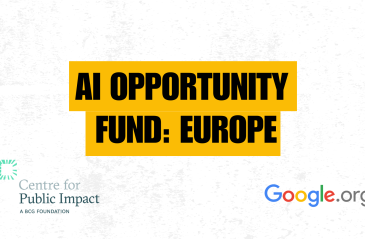
The power of storytelling in climate leadership

The Public Impact Gap is a tool to help governments understand the outcomes they achieve
Share articleIt measures the gap between the outcomes it achieves and the outcomes it *could* be achieving
Share articleThe tool evaluates a country's performance compared against its global peers
Share articleWe put our vision for government into practice through learning partner projects that align with our values and help reimagine government so that it works for everyone.
Just prior to the launch of the Centre for Public Impact nearly two years ago, I sat down to write this blog. Rereading it now - always a danger for any writer - I can't help but note how much has changed.
Innovation labs have become even more prevalent across the global government landscape. Approaches like behavioural insights and design have taken firmer root. Digital has evolved into a looming era of artificial intelligence. And that's not even counting Brexit or phenomena such as "post-truth".
The passage of time has not altered everything, however. Governments continue to struggle with turning policies into positive impact. There continues to be an “impact imperative”, whereby citizens' frustration with substandard public services and poor value for money can morph into cynicism about the political process and democracy more generally. And remember - when governments fall short, it matters. Improving citizen outcomes is not just a technical phrase deployed by those of us in and around government. Out there in the real world, it means higher living standards, better schools, increased survival rates from life-threatening diseases, and much more besides.
That's why we have created the Public Impact Gap, which is the difference between the outcomes a government is achieving, and the outcomes it could be achieving. In other words, it is a measure of potential as well as a way of describing how far a government is falling short.
We all want governments to perform better. That's no secret. But over the past couple of years, we have found it as hard to understand the actual outcomes of governments' policies as to speculate on the outcomes that governments could have achieved. Outcomes rarely feature in conversations around performance and, even when data is available, it tends to focus on spending levels or programme activities.
To understand what could have been achieved, we have often sought to place a country's performance in a global context. For example, it is great news that a country has improved its gender equality outcomes, but what if the approach of another country had delivered even better equality outcomes? This highlights what could have been achieved, and is therefore likely to be a better benchmark than the country's own historical performance.
The Public Impact Gap is a way of tracking outcomes and, at the same time, evaluating a country's performance compared with that of its peers. In our analysis, we take a set of outcomes for a group of similarly situated governments (which could be of countries, states or cities) and measure the gap between the performance of each one and a challenging but achievable benchmark. In this way, the Public Impact Gap tells us how far a government is falling behind its peer group standard.
We calculate it in three steps. First, select an outcomes-based indicator for which comparative data is available. Second, select a peer group of governments (of countries, states or cities, etc) that are similarly situated. Third, measure the gap to the 75th percentile performance for each government in the peer group. All governments performing below the benchmark level have a Public Impact Gap to close.
In our report, we have highlighted three examples covering key outcomes in health, education and safety, but there are doubtless many other sectors where it could be applied. With this in mind, we hope that the Public Impact Gap will serve as a conversation-starter in governments around the world. Once a government identifies that a Public Impact Gap exists, the Public Impact Fundamentals and the Public Impact Observatory can help explain why it has emerged and how we can help close it.
But this will be an ongoing process. We want to hear from you. What do you think of the Public Impact Gap? Where can it be applied? What are the best ways for governments to close the Gap? Answering those questions will strengthen our methodology and analysis but also, far more importantly, help improve the performance of governments and give people around the world the opportunity to live longer, happier and more secure lives. Now that's a prize worth fighting for.
Helping governments bridge the gap between intentions and performance. The ideal of good government is one shared by billions of people around the world but more needs to be done for it to become a reality, says Adrian Brown
Recognising and renewing governments' legitimacy. Preserving their legitimacy in such a fast-changing world should be a priority for governments the world over, says Maryantonett Flumian
Action stations: advancing to impact. Beth Blauer explains why management, measurement and alignment are critical to the successful transition of a policy into real-world effect.
Picking the policy that will have the greatest impact. Overcoming the barriers to policy implementation involves not only the setting of priorities and ambition but also defining what outcome is actually intended, says Sir Michael Barber
Learning the lessons of impact: introducing the Public Impact Observatory. Interested in how governments around the world attempt to turn ideas into impact? Then The Public Impact Observatory can help. Joel Tito explains how…












